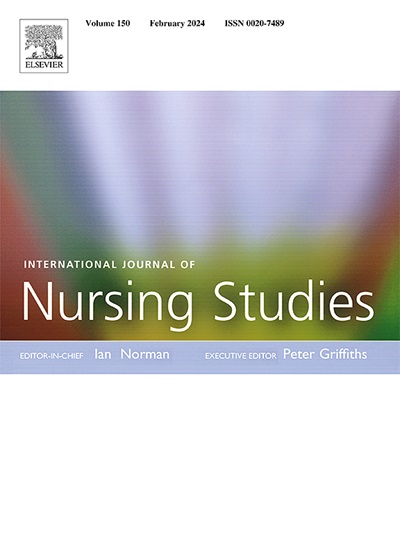基于昼夜节律调节的标准化沟通系统对青少年和青年癌症患者心理困扰的影响:一项随机对照试验
IF 7.1
1区 医学
Q1 NURSING
引用次数: 0
摘要
背景青少年和青年癌症患者心理困扰的多种因素不断被发现,表明有必要探索满足个性化心理需求的干预措施,并将其融入日常生活中,以减轻他们的心理困扰。目的探讨基于昼夜节律调节的标准化沟通系统对青少年和青壮年癌症患者心理困扰的影响。设计一项三组随机对照试验。研究环境与参与者选取了2022年1月至2023年5月在中南大学湘雅第三医院就诊的129例有心理困扰的青少年和青壮年癌症患者。方法随机分为3组。两组均接受8个标准化沟通系统干预话题,对照组仅接受常规心理护理。两个干预组的不同之处在于,干预组2的干预持续时间与研究参与者的三种昼夜节律相匹配。心理困扰、焦虑和抑郁的主要结果,以及睡眠质量和生活质量的次要结果,在基线、完成干预后立即、完成干预后一个月和三个月分别测量了四次。使用广义估计方程来比较三组间干预的效果。结果干预1个月后,两组青少年和青年癌症患者的心理困扰、焦虑、抑郁、睡眠质量和生活质量均较对照组显著降低(P < 0.01)。同时,干预组2在减轻患者心理困扰(- 1.20,CI, - 1.82 ~ - 0.57, P < 0.001)和改善患者睡眠质量(- 1.72,CI, - 2.83 ~ - 0.62, P < 0.001)方面均优于干预组1。此外,干预结束后3个月,效果持续(P < 0.05)。结论标准化沟通系统干预能有效缓解青少年癌症患者的心理困扰、焦虑、抑郁,改善青少年癌症患者的睡眠质量和生活质量。此外,基于昼夜节律调节的标准化沟通系统比标准化沟通系统干预更有利于改善青少年和青壮年癌症患者的心理困扰和睡眠质量。该研究已于2022年1月3日在中国临床试验注册中心注册(ChiCTR2200055230)。本文章由计算机程序翻译,如有差异,请以英文原文为准。
Effects of the standardized communication system based on circadian rhythm regulation in psychological distress of adolescent and young adult cancer patients: A randomized controlled trial
Background
Multiple factors of psychological distress in adolescent and young cancer patients continue to be unearthed, suggesting the warranted exploration of interventions that meet individualized psychological needs and are integrated into daily lives to alleviate their psychological distress.
Objective
To investigate the effects of the standardized communication system based on circadian rhythm regulation on psychological distress in adolescent and young adult cancer patients.
Design
A three-arm randomized controlled trial.
Setting and participants
A total of 129 adolescent and young adult cancer patients with psychological distress were recruited from the Third Xiangya Hospital of Central South University from January 2022 to May 2023.
Methods
Participants were randomly divided into three groups. Both intervention groups received eight standardized communication system intervention topics, while the control group received only routine psychological care. The difference between the two intervention groups was that the duration of the intervention in the intervention group 2 was matched to the three types of circadian rhythm of the study participants. The primary outcomes of psychological distress, anxiety, and depression, as well as the secondary outcomes of sleep quality and quality of life, were measured four times at baseline, immediately after completing the intervention, and one month versus three months after completing the intervention. The generalized estimating equations were used to compare the effects of the intervention across the three groups.
Results
In one month after the intervention, the two intervention groups significantly reduced psychological distress, anxiety, and depression, and improved the quality of sleep and quality of life in adolescent and young adult cancer patients compared to the control group (P < 0.01). Meanwhile, the intervention group 2 was more effective than the intervention group 1 in reducing psychological distress (− 1.20, CI, − 1.82 to − 0.57, P < 0.001) and improving sleep quality (− 1.72, CI, − 2.83 to − 0.62, P < 0.001) of patients. Moreover, the effects persisted three months after completing the intervention (P < 0.05).
Conclusions
The standardized communication system interventions can effectively alleviate psychological distress, anxiety, and depression, and improve sleep quality and quality of life in adolescent and young adult cancer patients. In addition, the standardized communication system based on circadian rhythm regulation is more advantageous in improving the psychological distress and sleep quality of adolescent and young adult cancer patients than the standardized communication system intervention.
Registration
The study was registered in the Chinese Clinical Trial Registry on January 3, 2022 (ChiCTR2200055230).
求助全文
通过发布文献求助,成功后即可免费获取论文全文。
去求助
来源期刊
CiteScore
15.00
自引率
2.50%
发文量
181
审稿时长
21 days
期刊介绍:
The International Journal of Nursing Studies (IJNS) is a highly respected journal that has been publishing original peer-reviewed articles since 1963. It provides a forum for original research and scholarship about health care delivery, organisation, management, workforce, policy, and research methods relevant to nursing, midwifery, and other health related professions. The journal aims to support evidence informed policy and practice by publishing research, systematic and other scholarly reviews, critical discussion, and commentary of the highest standard. The IJNS is indexed in major databases including PubMed, Medline, Thomson Reuters - Science Citation Index, Scopus, Thomson Reuters - Social Science Citation Index, CINAHL, and the BNI (British Nursing Index).

 求助内容:
求助内容: 应助结果提醒方式:
应助结果提醒方式:


